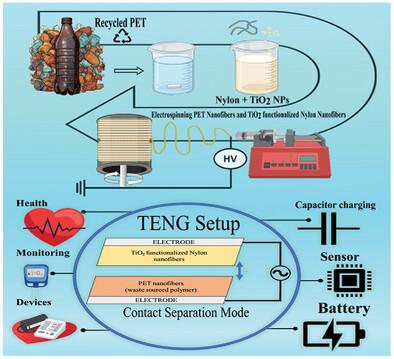Sustainable Electrospun Hybrid Nanofibers for Triboelectric Nanogenerators
IF 13
2区 材料科学
Q1 CHEMISTRY, MULTIDISCIPLINARY
引用次数: 0
Abstract
Triboelectric nanogenerators (TENGs) have emerged as potential energy-harvesting modules for miniaturized devices. TENG modules are derived often from components having low sustainability whereas the current environmental and economic circumstances demand a focus on sustainable, ecologically friendly approaches for the development of advanced hybrid materials. Herein, recycled polyethylene terephthalate (PET) along with commercially available nylon are electrospun into nanofibers for TENG devices. The obtained nanofibers are characterized using microscopy, spectroscopy, and thermal and mechanical analysis. Electrospinning of pristine and titanium dioxide nanoparticles (TiO2 NPs) blended polymer solutions resulted in uniform nanofibers without beads. The addition of TiO2 NPs improved the thermal properties and significantly improved the mechanical stability of the nanofibers. The performance of the fabricated TENG device has been improved by functionalizing the nanofibers with TiO2 NPs. Particularly, the combination of pristine PET and TiO2 NPs (5%) functionalized nylon nanofibers reached a peak power density of 23.44 mW m−2 with a surface charge density of 6.81 µC m−2, a max output voltage of 111 V and a max current of −1.61µA. This study opens a new avenue to utilize upcycled cost-effective polymers processed using electrospinning as a powerful tool for the fabrication of the next generation of sustainable TENG devices.

求助全文
约1分钟内获得全文
求助全文
来源期刊

Small
工程技术-材料科学:综合
CiteScore
17.70
自引率
3.80%
发文量
1830
审稿时长
2.1 months
期刊介绍:
Small serves as an exceptional platform for both experimental and theoretical studies in fundamental and applied interdisciplinary research at the nano- and microscale. The journal offers a compelling mix of peer-reviewed Research Articles, Reviews, Perspectives, and Comments.
With a remarkable 2022 Journal Impact Factor of 13.3 (Journal Citation Reports from Clarivate Analytics, 2023), Small remains among the top multidisciplinary journals, covering a wide range of topics at the interface of materials science, chemistry, physics, engineering, medicine, and biology.
Small's readership includes biochemists, biologists, biomedical scientists, chemists, engineers, information technologists, materials scientists, physicists, and theoreticians alike.
 求助内容:
求助内容: 应助结果提醒方式:
应助结果提醒方式:


